With its distinctive scent, evoking warmth, holidays and the Mediterranean, lavender perfumes garden and bouquets. It is also used in various recipes for pastries, cakes, jam, liqueur, tisane and drinks. Among these, lavender syrup is simple to make and brings a surprising flavour. Discover our easy homemade lavender syrup recipe.
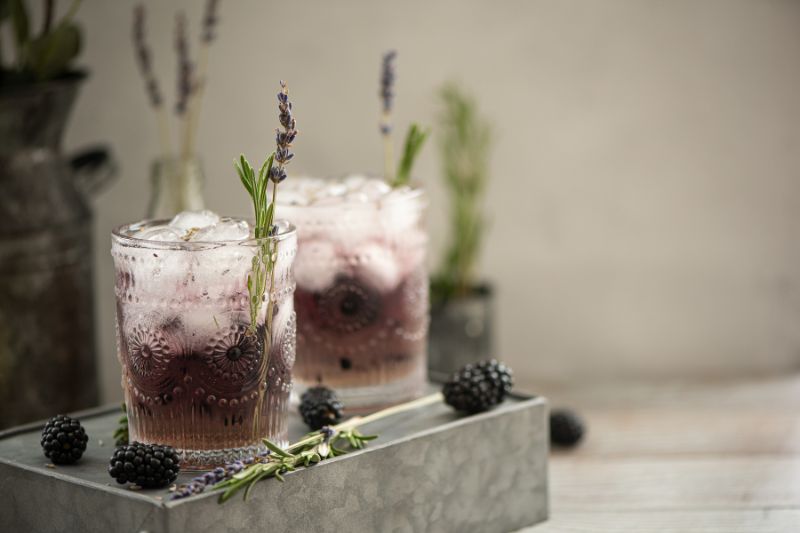
When, how and where to harvest lavender?
Lavender is harvested at start of summer, when flowers are not yet fully open, between June and July depending on region. Picking is best done in morning on a sunny day, as that time of day is when flower spikes are most fragrant.
To harvest, use scissors or a pruning shear disinfected beforehand to avoid spreading diseases between plants. Cut tip of stems bearing flower spikes, well above leaves.
Be careful to always pick lavender that has not received any chemical treatment. Also avoid harvesting lavender by busy roads or close to frequently walked paths where dogs may mark their territory.

Which lavender variety to choose?
There are many lavender varieties, but for cooking and tisane, favour lavender officinalis (Lavandula angustifolia) above all. You may also know it as "English lavender" or "true lavender". This species comes in several cultivars; here is a short selection:
- Lavandula angustifolia 'Essence Purple' is a blue‑violet flowering variety, much appreciated for long flowering from June to August and good hardiness.
- Lavandula angustifolia 'Siesta' is one of the tallest lavenders, thanks to its long flower stems, reaching up to 80 cm. It has silvery‑green foliage and deep blue‑violet flowers.
- Lavandula angustifolia 'Hidcote' has aromatic grey‑green foliage and abundant, highly fragrant deep violet summer flowering.
- Lavandula angustifolia 'Rosea' stands out for its pink‑lilac flowers above aromatic green foliage.
- Lavandula angustifolia 'Arctic Snow' produces a surprising pure white, fragrant summer display. With its grey‑green foliage it brings brightness to garden.
→ Discover all our lavender varieties.
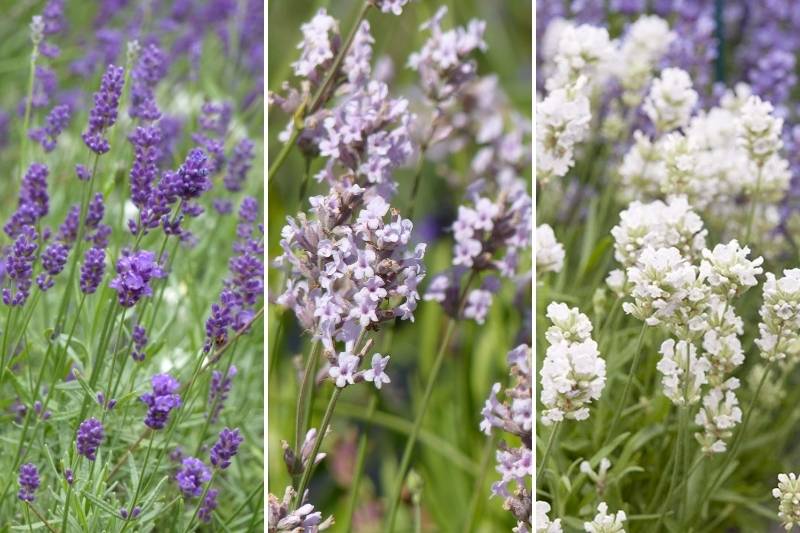
Fresh lavender or dried lavender?
For this recipe, you can use dried sprigs or freshly picked lavender. Taste and aroma will be slightly different, as sprigs do not release exactly same scents and flavours. Advantage of dried lavender is that it allows recipes year‑round!
→ Read our article: "How to dry lavender?"
Homemade lavender syrup recipe
Ingredients :
- 50 cl water
- 30 g fresh lavender (entire flower spikes) or dried lavender (entire or stripped flower spikes)
- 400 g sugar
- Facultative: 5 cl lemon juice or half an organic lemon to extend preservation
- a saucepan
- a fine‑mesh sieve (chinois or tamis). If none available, use a clean tea towel
- a wooden spoon
- a sterilised bottle or jam jar to store syrup
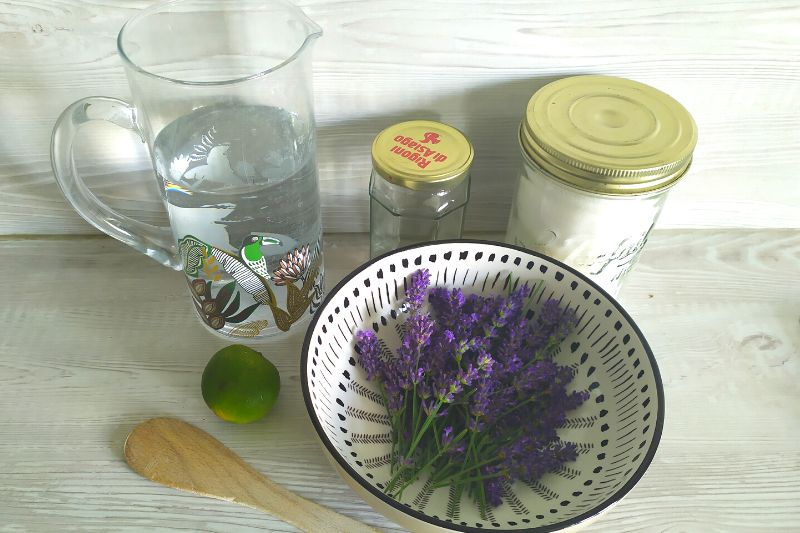
Method :
- 1/ If using fresh lavender, start by shaking floral stems in garden after picking. Indeed, many tiny insects hide in these delicious melliferous flowers. Next, you can rinse them under cold tap water to remove any last tiny inhabitants and impurities.
- 2/ Remove leaves and stem pieces without flowers to keep only flower tips. No need to strip individual flowers.
- 3/ Place lavender flowers in a saucepan, then pour in water and, if using, lemon juice.
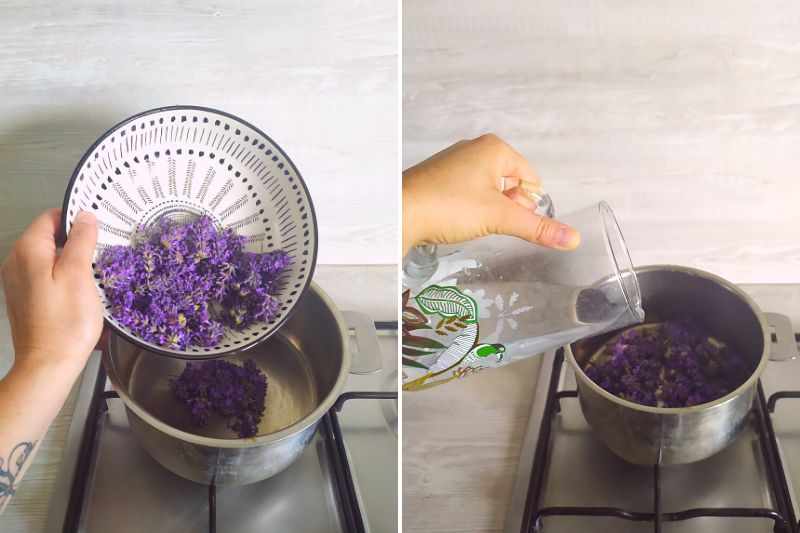
- 4/ Put saucepan over low heat, then turn off heat at first signs of boiling.
- 5/ Cover saucepan with lid and let flowers infuse for 2 to 3 hours at room temperature.
- 6/ When maceration is complete, strain preparation through a fine sieve (personally I use a chinois), to extract only the juice. Press flowers with wooden spoon to extract as much liquid as possible.
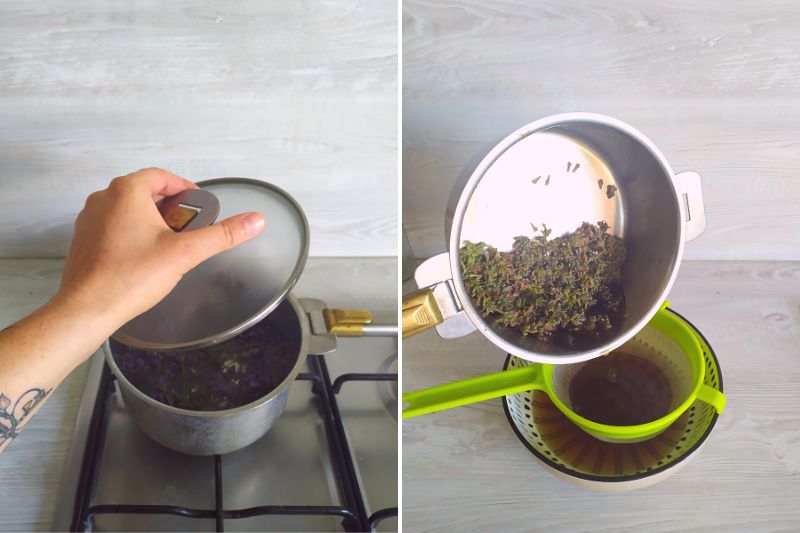
- 7/ Pour juice into a saucepan.
- 8/ Add sugar.
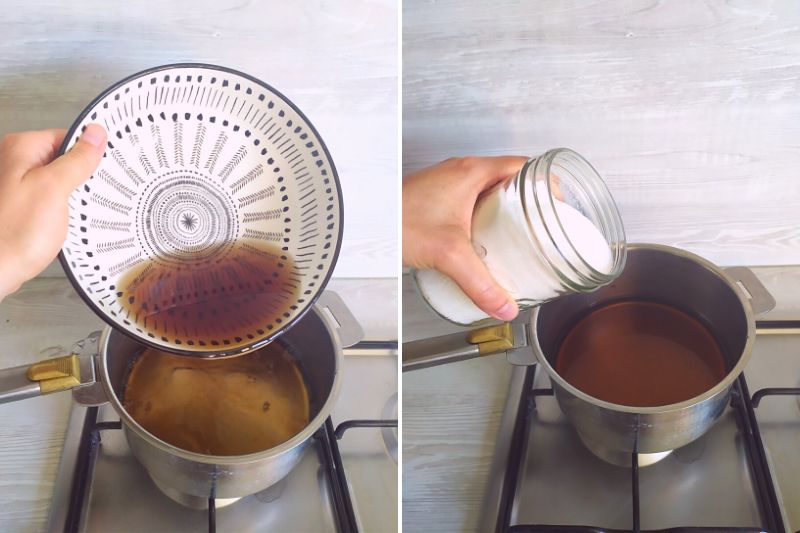
- 9/ Place saucepan over low heat and cook mixture for 10 minutes, stirring frequently to dissolve sugar well.
- 10/ Without letting syrup cool, pour it quickly into a sterilised bottle or jar.
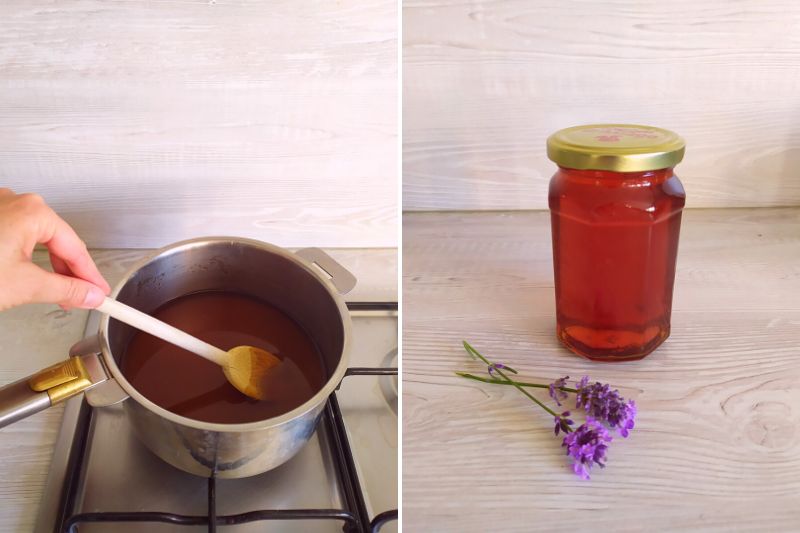
Tips :
- If homemade lavender syrup turns caramel in colour, that is perfectly normal. Even if flower is mauve, pink or white, it is very difficult to obtain a purple colour without artificial colourings and, even then, result is not guaranteed! I have personally tested and never achieved a nice purple shade with colourings.
- You can obtain a plum‑toned hue by preparing lavender syrup with dark small fruits, such as blackcurrant, blueberry or blackberry berries. Raspberries will give a pinker colour.
How long does lavender syrup keep?
You can keep lavender syrup for up to one month if stored in refrigerator.
Recipe ideas:
- Lavender syrup is ideal to flavour drinks, by simply adding 1–2 tablespoons of syrup to a glass of still or sparkling water. It can also be used in cocktail preparation. For extra freshness, add some ice cubes, stir and enjoy! For decoration, hang a small sprig of lavender on side of glass or add a few blackberries to drink.
- Why not use it as a coulis? It will add an original touch to ice cream and sorbets, cakes and tarts, and also as a topping for crumbles, pancakes, yoghurts and biscuits.
- I also discovered a surprising latte recipe flavoured with lavender or violet syrup!
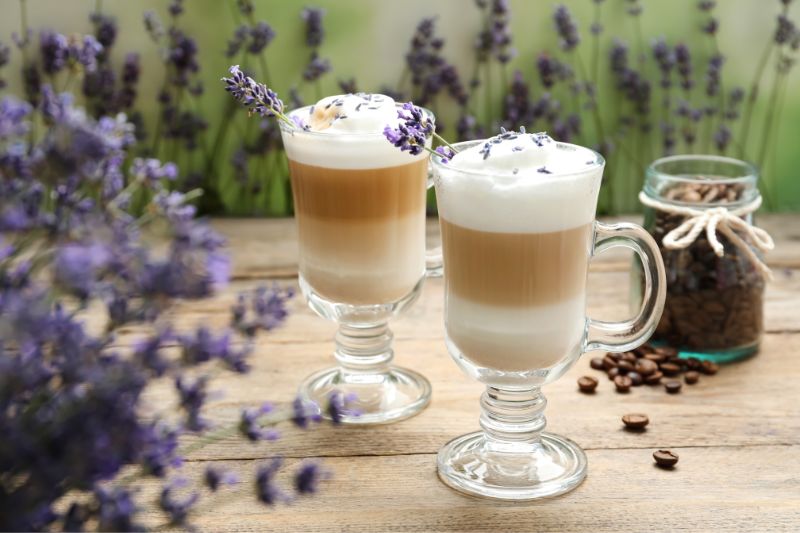
To go further :
- Find all our lavender varieties.
- For everything you need to know, read our full page on lavender: planting, growing and pruning
- Discover our article: how to dry lavender?































![[plant] is a wonderful plant to grow in the garden, not only for its beautiful purple flowers but also for its many culinary uses. One way to enjoy the delicate flavour of lavender is by making [plant name="sirop de lavande" usage="sirop"].
To make [plant name="sirop de lavande"], you will need the following ingredients:
- 1 cup of water
- 1 cup of sugar
- 2 tablespoons of dried [plant name="lavande"] flowers
Here's how to make [plant name="sirop de lavande"]:
1. In a saucepan, combine the water and sugar.
2. Heat the mixture over medium heat, stirring until the sugar is completely dissolved.
3. Add the dried [plant name="lavande"] flowers to the saucepan.
4. Bring the mixture to a simmer and let it cook for about 10 minutes.
5. Remove the saucepan from the heat and let the [plant name="sirop de lavande"] cool completely.
6. Strain the mixture to remove the [plant name="lavande"] flowers.
7. Transfer the [plant name="sirop de lavande"] to a clean glass bottle or jar for storage.
You can use [plant name="sirop de lavande"] to flavour cocktails, lemonade, or even drizzle it over desserts like ice cream or cakes for a touch of floral sweetness. Enjoy experimenting with this fragrant syrup in your culinary creations! [lavender-syrup-recipe]](https://en.promessedefleurs.eu/blogwp/wp-content/uploads/2022/08/Comment-faire-du-sirop-de-lavande-.jpg)
Comments